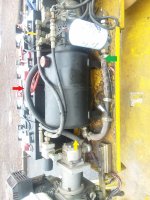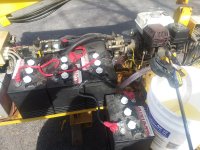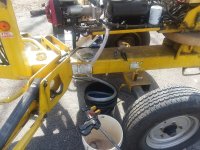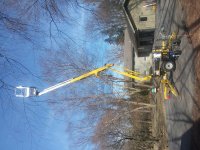You are using an out of date browser. It may not display this or other websites correctly.
You should upgrade or use an alternative browser.
You should upgrade or use an alternative browser.
Can I change hydraulic fluid like this
- Thread starter BeezFun
- Start date
- Views: 3232
/ Can I change hydraulic fluid like this
#11
One more question, in this photo the yellow arrow points to the inlet on the gas driven pump. I'll pull that hose and connect a short piece of hose that I'll stick into a pail of new hydraulic fluid. The green arrow points to the hose that comes out of the bottom of the reservoir, goes into the white filter, and then turns back under the reservoir and pops up on the other side where the red arrow is pointing. My question is why did they run that hose up in the air where the red arrow is pointing? It would have been cleaner, easier and cheaper to keep it flat behind the reservoir and just plumb it straight into the spot where the yellow arrow is. Can that big loop up in the air serve any purpose?


oldnslo
Super Member
no reason I can think of to run the hose like that. Possibly not original hose and previous owner installed a piece of hose that he could find or guessed at the length
oldnslo
Super Member
Just noticed there are two single acting cylinders on your lift you could collapse these fully before the fluid change and that would remove majority of old fluid from this portion of the circuit
I'm embarrassed to say I just noticed the same thing. There are 4 hoses coming to each cylinder and I just didn't think about it, duh. This makes the transfer faster because there are only 5 large double acting cylinders, 4 of them are on the outriggers.Just noticed there are two single acting cylinders on your lift you could collapse these fully before the fluid change and that would remove majority of old fluid from this portion of the circuit
One complication I just realized is that the thing won't work without the batteries hooked up even when I use the gas engine. There is no generator, so the batteries supply the electrical controls power even when the gas engine is running. That makes it a bit harder to get at the hose fittings and hoses. I might set the batteries on the ground and jumper them up to the system wiring.
oldnslo
Super Member
Do you know if the coils are 12 or 24 VDC? If 12 you only need one battery. The extra batteries are for the DC power unit since they are amperage hogs.
Suspect the gas engine has an alternator to the battery charged also.
Suspect the gas engine has an alternator to the battery charged also.
It's 12v, it uses four 6v golf cart batteries connected series/parallel to produce 12v and about 750A. That's a good point, it would be easier to just use the extra 12v car battery I have to make the controls come alive.Do you know if the coils are 12 or 24 VDC? If 12 you only need one battery. The extra batteries are for the DC power unit since they are amperage hogs.
I wish. When I first bought the thing I assumed the engine would charge the batteries, but that didn't seem to be happening. So I got a copy of the schematic and couldn't see anything but the battery charger. I called the company, they said the only source of charging is the battery charger. So every night I have to plug the thing in. Even if they had added a small extra 12v battery for the controls with a small alternator to keep it charged, that would at least allow the thing to stay out in the field without having to come home for charging. It can't be a weight issue, this thing is built like a locomotive. It must just be the extra cost makes them less competitive.Suspect the gas engine has an alternator to the battery charged also.
Another question, when I hook a length of hose up to the pump and put it in a pail of new fluid, that means there's about 3' of hose filled with air. Do I need to fill that hose length with fluid and keep it filled until I get the engine started? I was thinking I could hold the hose up like an elephant trunk, pour fluid in it, then hold some kind of plug lightly in the end while I put it in the pail. Then start the engine and remove the plug.
oldnslo
Super Member
Gear pump should self prime as long as the pressure port is open to tank.
Mission accomplished. I found some cheap reinforced hose that was pretty flexible at Menards, had to remove one of the batteries to get at the suction fitting on the pump.
Here's the suction side of the pump drawing out of new pail of fluid:

Here's the drain from the reservoir:

And here it is with all cylinders extended:

Here's the suction side of the pump drawing out of new pail of fluid:

Here's the drain from the reservoir:

And here it is with all cylinders extended:


